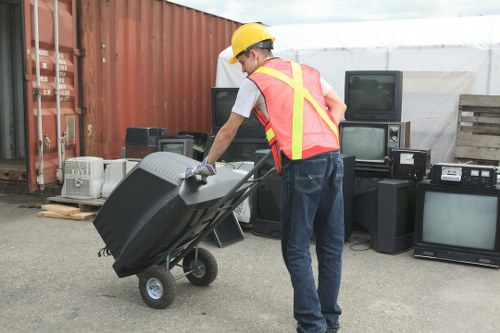Waste Clearance Covent Garden

Waste clearance in Covent Garden is a critical service that not only keeps the historic heart of London clean but also protects the community and local businesses. In this bustling locale, waste clearance is carried out by dedicated professionals who understand both the local restrictions and the importance of eco-friendly practices. The natural beauty and cultural heritage of Covent Garden deserve to be preserved, and proper disposal and recycling efforts play an essential role in maintaining the area’s charm.
From theatre districts to street markets, waste clearance is a service that affects everyone in Covent Garden. Local authorities and sanitation experts work closely together to manage waste in a systematic way, ensuring that all refuse is disposed of in an efficient and sustainable manner. Daily tasks such as pickup, segregation, and recycling are managed with serious empathy for the environment and the people who call this area home.
The importance of waste management cannot be overstated. The combination of historical significance and modern urban challenges in Covent Garden requires a balanced approach between robust technical solutions and community engagement. This article explores various aspects of waste clearance in this iconic area, discussing the methods, challenges, and future prospects. It is a journey into a world where environmental responsibility and urban planning meet, ensuring a livable and vibrant city center for residents and visitors alike.

Understanding Waste Clearance in Covent Garden
In Covent Garden, waste clearance services extend far beyond the removal of everyday garbage. These services include the collection of recyclables, the safe disposal of bulky items, and even the removal of hazardous materials. Local waste management companies employ modern techniques and equipment to perform these tasks efficiently. Eco-friendly practices such as recycling and composting are standard, ensuring that the area minimizes its environmental footprint while preserving its aesthetic appeal.
A key element of effective waste clearance is the adoption of sustainable practices. Many companies now use energy-efficient vehicles and training programs designed to reduce carbon emissions. This ensures that every step of the waste clearance process contributes to a cleaner environment. By using innovative approaches, the contractors help lower the volume of waste that ends up in landfills, thereby protecting the local ecosystem and reducing pollution in the busy urban setting of Covent Garden.
Furthermore, waste clearance in Covent Garden is supported by a range of public policies aimed at sustainability. Local councils have implemented strict guidelines for waste segregation and recycling, making it easier for residents and businesses to contribute positively. As a result, municipal waste management is integrated with community initiatives, ensuring that every single effort counts. This well-planned structure offers lessons not only for Covent Garden but also for other regions striving to improve their environmental performance.

The Benefits of Efficient Waste Clearance
Efficient waste clearance in Covent Garden offers numerous benefits. First, it improves public health by reducing the chances of unsanitary conditions and controlling the spread of diseases. Clean streets, free of clutter and debris, create safer environments not only for the elderly and children but for all visitors to this lively district. Every scheduled collection day is a reminder of the commitment to prioritizing the well-being of the community through environmental measures.
Second, a well-organized waste management system boosts the local economy. Tourists are more likely to visit an area that is clean and well maintained, which in turn benefits local shops, restaurants, and entertainment centers. Businesses in Covent Garden thrive when there is a sense of pride in the neighborhood. Waste clearance initiatives help sustain this pride by maintaining the integrity and allure of the area, reinforcing Covent Garden as a must-visit destination in London.
Third, the integration of advanced recycling processes helps reduce the amount of waste sent to landfills. This progressive approach not only conserves natural resources but also reduces the environmental impact associated with waste processing. The focus on recycling and reusing materials aligns with global trends towards sustainability and responsible consumption. By emphasizing environmental stewardship, Covent Garden sets a standard for modern urban centers dealing with waste management issues.

Challenges and Innovative Solutions in Waste Clearance
The busy streets of Covent Garden pose unique challenges to waste clearance operations. The high volume of foot traffic and the concentration of commercial activities create logistical complexities. Narrow lanes and historical buildings limit the type of vehicles that can be used for collection. As a result, waste management companies have been challenged to design innovative solutions that can operate under such constraints without compromising efficiency or safety.
One of the main challenges is managing waste during major local events. Covent Garden is known for its vibrant festivals, street performances, and cultural events that draw large crowds. During these times, waste clearance schedules must be adjusted to accommodate the increased volume of refuse. This often involves expanding volunteer programs, hiring additional support, and employing temporary, specialized equipment to cope with the surge. The commitment to clear and safe urban areas is evident in the meticulous planning and adaptation by professionals in the field.
To overcome these challenges, many companies are turning to technology and innovation. GPS tracking on collection vehicles, real-time monitoring of waste bins, and smart route optimization software enable efficient planning. Many local businesses have also partnered with waste management services to develop tailored solutions. These measures ensure timely clearance and help avoid bottlenecks during peak periods. The incorporation of modern technology in waste clearance not only shortens the response time but also enhances the quality of life for residents and visitors.

Local Impact and Nearby Areas of Waste Clearance
The significance of waste clearance extends beyond Covent Garden’s immediate boundaries. The surrounding areas benefit as well from robust waste management practices. For example, Soho enjoys similar services by nearby waste contractors who ensure that the vibrant nightlife and entertainment venues remain untarnished by litter and debris. In Holborn, fast response times mean that waste does not accumulate near office spaces or educational institutions.
Other nearby areas such as Bloomsbury and Fitzrovia share in the benefits of integrated waste management systems. These districts are known for their academic institutions, galleries, and historic architecture, making cleanliness critical. Waste clearance practices that are efficient in Covent Garden often inspire similar initiatives in adjacent neighborhoods, creating a ripple effect that positively affects the entire central London community.
Local authorities continually work with community organizations to promote cleanliness and environmental responsibility. The focus is on a collaborative approach that involves residents, small business owners, and local councils working together to challenge and overcome waste management issues. Clear and practical strategies ensure that streets remain clean and that waste clearance is carried out in an ethical and sustainable manner. This collective effort keeps the spirit of Covent Garden vibrant and is a model for urban centers around the world.
Waste Clearance: Services, Practices, and Future Outlook

When discussing waste clearance in Covent Garden, it is important to note the variety of services available. Local companies typically offer a range of options tailored to the specific needs of residents and businesses. These services include routine garbage collection, recycling program participation, and even special clearance requests during festivals or after major public events. The structured schedules and advanced logistics ensure that waste does not accumulate, preserving the historical beauty and the liveliness of this central London district.
Service providers often operate on flexible timetables to ensure minimal disruption to daily activities. In busy sectors like Covent Garden, waste collection schedules are coordinated to avoid peak hours, reducing the chance of traffic congestion and offering seamless service to the public. Facilities are designed to handle different types of waste, segregating recyclables from non-recyclable material to maximize reuse and recovery rates. This diverse approach to waste clearance underscores the importance of customized solutions for urban resilience.
The future of waste clearance in Covent Garden looks bright, fueled by ongoing innovations and improvements in sustainability practices. The integration of digital tools, such as mobile applications for reporting and tracking waste collection needs, allows residents to participate more actively in maintaining cleanliness. There is also a growing trend among waste management companies to adopt circular economy principles, where waste is seen as a resource rather than a problem. The synergy between technology and eco-friendly practices is paving the way for a cleaner, greener future in Covent Garden.

Exploring the Environmental and Social Impact
Environmental awareness has become a central tenet of waste clearance strategies in Covent Garden. The area has adopted significant measures to minimize the environmental footprint of waste management activities. These efforts include strict recycling protocols, the use of biodegradable materials for waste collection, and a persistent drive towards reducing greenhouse gas emissions from transport vehicles. With sustainability at the forefront, every step in the waste clearance process is designed to protect not only the urban environment but also the natural world.
Social impact is equally important. By maintaining a clean environment, waste management practices improve the quality of life for residents and create a welcoming atmosphere for tourists. Community outreach programs educate local inhabitants on the importance of responsible waste disposal and environmental conservation. Such initiatives foster a sense of collective responsibility and ensure that the impact of waste clearance extends beyond the physical transformation of the area.
This dual focus on environmental and social benefits makes waste clearance in Covent Garden an exemplar of modern urban management. Both public and private sectors collaborate to ensure that waste clearance is handled humanely and efficiently. Programs aimed at encouraging public participation and promoting recycling have seen significant success, and these positive trends are likely to continue in the years ahead, reinforcing the community’s commitment to a sustainable future.

A Closer Look at Nearby Areas and Their Unique Attributes
Covent Garden is bordered by Soho, a bustling area known for its eclectic nightlife, theaters, and dining experiences. The proximity of Soho to Covent Garden means that waste clearance initiatives now and then overlap, creating a seamless experience for visitors traveling between these vibrant locales. Waste management companies often coordinate across these areas to ensure a consistent standard of cleanliness irrespective of local differences.
Another nearby district, Holborn, is rich in history and education. The presence of universities and libraries in Holborn increases the importance of maintaining clean streets for the well-being of both students and professionals. In addition, Bloomsbury with its literary history and academic reputation depends heavily on organized waste clearance to preserve its intellectual ambiance and historic buildings.
Additional areas benefiting from excellent waste clearance services include Fitzrovia, known for its artistic hubs; Mayfair, synonymous with luxury shopping and fine dining; Leicester Square and Trafalgar Square, famous for tourism and cultural events; and Piccadilly, a major thoroughfare that sees high pedestrian traffic. Each of these areas boasts its own unique features and requires waste management solutions that are both scalable and sensitive to local needs.
Frequently Asked Questions About Waste Clearance Covent Garden

Q1: What types of waste are collected in Covent Garden?
A1: Waste clearance services in Covent Garden cover household garbage, recyclables such as paper, plastic, and glass, bulky items like furniture, and sometimes hazardous materials. The aim is to ensure that all waste is disposed of in an environmentally friendly manner.
Q2: How often is waste collected in Covent Garden?
A2: Waste is typically collected several times a week depending on the area and the type of waste. Special arrangements are often made during increased activity periods, such as festivals or events.
Q3: What steps are taken to ensure sustainable waste management?
A3: Companies use energy-efficient vehicles, enforce strict recycling protocols, and work closely with local authorities. They also integrate technology like GPS tracking to improve route planning and reduce carbon emissions.

Conclusion: A Cleaner Future for Covent Garden
Waste clearance in Covent Garden is more than just refuse collection—it is an ongoing commitment to protecting historical heritage, maintaining public health, and promoting environmental sustainability in a dynamic community. The city’s success in managing waste is an exemplary model for other urban centers facing similar challenges. With continuous improvements and community involvement, the future of Covent Garden looks brighter and greener.
Local businesses, residents, and municipal bodies continue to work together in refining waste clearance processes. This collaborative spirit has not only kept the streets clean but also fostered a deeper sense of responsibility and pride among community members. Every innovative strategy, every upgraded piece of equipment, and every reinforced guideline contributes to the ongoing effort of making Covent Garden a safe and welcoming place for everyone.
In summary, the dedication to efficient waste clearance in Covent Garden reflects both modern expertise and deep respect for the area’s cultural legacy. The shared vision for a sustainable, enjoyable urban environment is the cornerstone of these efforts, ensuring that both today's citizens and future generations can continue to enjoy one of London's most remarkable districts.
